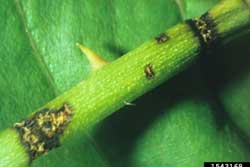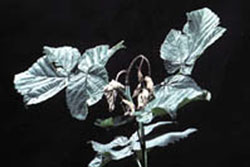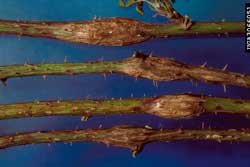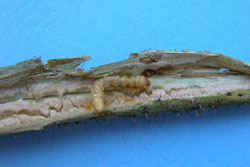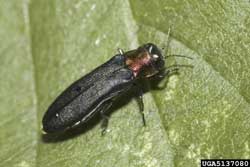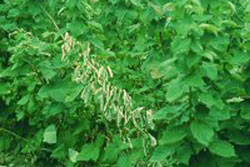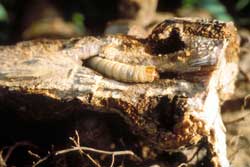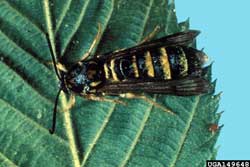Raspberry Borers
Raspberry Cane Borer
The raspberry cane borer is a ½ inch long black longhorned beetle (family Cerambycidae). It has yellow stripes on its elytra (wing covers), a yellow thorax (the section behind the head) with two black dots on it and antennae the length of the body. In spring, adult females deposit eggs between a double row of punctures made around stem tips. The eggs hatch in early summer and the whitish, brown-headed larvae bore several inches down the canes, overwinter at ground level, and emerge as adults in June. Look for a double row of punctures around the stem tip where the adult female laid her eggs. Cane wilting above the egg punctures is common with the cane dying the following season.
Red-necked Cane Borer
The red-necked cane borer is a blue-black, metallic wood-boring beetle (family Buprestidae) about ¼ inch long with a dull coppery color on the prothorax (the area just behind the head). Adult females first appear on canes in late May or early June, laying eggs in the cane bark. The ½ inch long, whitish larvae burrow under the bark and later bore into the pith. They overwinter in the canes. The boring causes the cane to swell ½ inch or more in diameter, several inches along the cane. The cane may die or break off at the swollen point.
Raspberry Crown Borer
The raspberry crown borer adult is a clear-winged moth (family Sesiidae) which resembles a wasp. In late summer, the adult female lays eggs on the underside of leaves. Eggs hatch in early fall and the larvae move to the soil, where they overwinter under the bark just below ground level. In spring and summer, the one inch long larvae feed in the roots and bottom of the canes (crown). They spend their second winter in the crown. The larvae pupate (make cocoons) and emerge as adults late the next summer. The leaves turn red prematurely and canes wilt in late summer. Affected canes die the following year. If only cane tips wilt, raspberry crown borer is not the problem.
Click on images to view full-size
Identification and Control Information
- Fact Sheet: Raspberry Cane Borer (PDF)—University of New Hampshire Cooperative Extension
- Integrated Pest Management: Raspberry Borers—University of Connecticut
- Fact Sheet: Rednecked and Raspberry Cane Borers (PDF)—University of Kentucky Cooperative Extension Service
More Information
- Growing Raspberries in Home Gardens (PDF)—Cornell Cooperative Extension
[Photos, left to right: Jim Baker, North Carolina State University, Bugwood.org; Ohio state university extension; James Solomon, USDA Forest Service, Bugwood.org; Queen's Printer for Ontario; Susan Ellis, Bugwood.org; Manitoba Agriculture, Food and Rural Initiatives; University of Georgia Plant Pathology Archive, University of Georgia, Bugwood.org; University of Georgia Plant Pathology Archive, University of Georgia, Bugwood.org]
